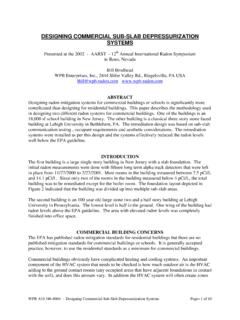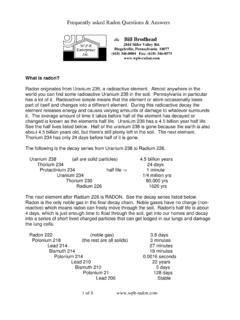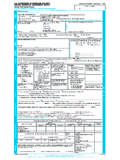Transcription of USING ASD TO MITIGATE CO METHANE AND …
1 WPB 610 346-8004 - USING ASD to MITIGATE CO2, METHANE and benzene Pages 1 of 14 USING ASD TO MITIGATE CO2 METHANE AND benzene Presented at the 2003 - AARST - 13th Annual International Radon Symposium in Nashville, TN Bill Brodhead WPB Enterprises, Inc. 2844 Slifer Valley Rd., Riegelsville, PA 18077 ABSTRACT Over the last few years, WPB Enterprises has been contracted to reduce CO2 in a number of residential buildings, METHANE in a commercial strip mall and benzene in a school building. Each of these has been successful mitigated. This paper will discuss the approaches taken with each of these gases and the results of the mitigations. INTRODUCTION In general the same techniques as those used with radon re-mediation can be used to control other gas entry. There are cases however where special considerations need to be taken into account because of the dangers that other gases may cause or because of the excessive air flow that may be coming out of the soil.
2 In these cases it is important that consultants with the needed expertise or the proper government officials be included in the initial system design and final installation. GASOLINE SPILLS In 1989, WPB was hired by NJ State Police to MITIGATE excessive gasoline fumes in a police barracks that was due to a leaking underground gasoline tank. WPB at that time had not installed an explosion proof fan. A compliance investigator for the NJ State Department of Environmental Protection was consulted over concerns about the regulations for venting gasoline fumes. The building was a simple ranch style structure that had an unfinished basement. A sub-slab pressurization system was chosen in order to avoid the hazard of venting gasoline fumes into the atmosphere and the associated risk with explosion.
3 The system included two pressure pits along the foundation wall where the highest concentrations of fumes had been measured. Two additional pressure pits with dampers in the pipe to reduce their flow were installed along the opposite foundation wall to ensure complete sub-slab pressurization. The basement was ventilated with window fans before any electrical tools were used. Each pit was constructed by boring a five inch hole through the slab and excavating two to four gallons of sub-slab material. A single 90 watt radon fan was mounted outside in a position to blow air down into the suction pits USING four inch pvc piping. All cracks in the slab were carefully sealed. Test holes indicated that good sub-slab pressure was achieved. The fan was installed at grade. WPB 610 346-8004 - USING ASD to MITIGATE CO2, METHANE and benzene Pages 2 of 14 A chimney cap installed on the inlet of the fan had filter fabric secured around the opening into the fan to prevent any accumulation of debris in the pressure pits.
4 The system included a u-tube monometer to indicate fan performance. Measurements made after the installation indicated no measurable traces of gasoline fumes. CARBON DIOXIDE (CO2) Carbon dioxide is produced by combustion and oxidation of materials containing carbon such as coal, oil and organic material. CO2 levels in the air are typically in the 300 to 400 ppm range. Inside a densely occupied room, such as a classroom, the levels can rise to 1000 ppm or higher. Levels above 1000 ppm ( ) can lead to sleepiness. Navy sub-marine personnel can sometimes become adjusted over a period of time to working in concentrations as high as 10,000 ppm ( ). 1000 ppm is equivalent to of the air. CO2 is, however, times more dense than air, so elevated concentrations are more likely at the slab level. Even if windows are open there can still be significant amounts of CO2 near the slab.
5 If levels of CO2 get above 2%, the furnace and water heater will not operate due to lack of oxygen. Oxygen (O2) in the air is typically around 21%. If levels of CO2 rise above 2 to 3 %, the reduction in oxygen poses a significant risk of losing consciousness and even death. RESIDENTIAL HOUSE IN CONSHOHOCKEN, PA In the fall of 1999 a mother was down in the basement of her home in Conshohoken when her daughter passed out while playing on the basement floor. She was able to carry her daughter outside where the daughter quickly recovered. When the local fireman arrived, one of the fireman passed out in the basement. The home was a two story detached house built in a new development of similar homes. The home was only four years old. CO2 and O2 were measured in the open sump of this house and the next door neighbor s basement sump for two months before the ASD system was installed.
6 During this period the CO2 levels ranged from normal levels up to 80,000 to over 100,000 ppm ( 10%). The corresponding O2 levels ranged from normal 21% to as little as 5%. There were periods were the O2 levels in the sump were below 10% for two or three days. There was no known landfill or unusual soil conditions under either house. In November of 1999, WPB was asked to install a typical radon ASD system in the residence. The ASD system consisted of a single suction point that was vented with four inch pvc to a fan installed outside. The exhaust was vent above the roof eave. The sump pump was sealed. The perimeter of the basement had an open canal drain that was sealed with backer rod and urethane caulking. A 50 watt, RP145 radon fan was used. The final u-tube reading was 7/8 static inches of water.
7 The pressure under the slab at the farthest distance from the suction point was negative 48 pascals. Continuous CO2 measurements were made during the ASD installation to ensure safe conditions existed. The CO2 and O2 levels returned to normal after the fan was activated. The levels were monitored for three weeks after the ASD system was installed with no significant increases in CO2. The WPB 610 346-8004 - USING ASD to MITIGATE CO2, METHANE and benzene Pages 3 of 14 CO2 levels in the adjoining neighbors house also returned to normal levels even though the system was only installed in the first house. RESIDENTIAL HOUSE IN POTTSVILLE, PA In December of 1999, WPB was contacted by the United States Department of the Interior, Office of Surface Mining, Reclamation and Enforcement about a house in Pottsville, PA that had elevated radon and CO2.
8 The house was a 2500 square foot raised ranch that was only one year old. The radon levels were around 200 pCi/l. in the basement and 56 pCi/l on the first floor. The builder had installed a loop of perforated piping around the inside of the foundation footer in the gravel bed below the slab. The owner was initially complaining that the oil furnace would not function properly. The house is located in an area that contains old underground coal mines. The initial visit by the Office of Surface Mining found levels as high as 4% CO2 near the floor of the basement with a dangerous level of only O2. A butane lighter could not produce a flame as it approached the floor. CO2 levels of 2% were found on the first floor and on the second floor, even though the heating system was hot water baseboard.
9 The house was ventilated until the oxygen levels returned to Within three days the levels in the basement had deteriorated to oxygen. Office of Surface Mining maps indicated mining occurred just to the north and south of the home. It was unknown if bootleg mining (non-recorded mining) had occurred beneath the home. Probe holes were drilled around the outside of the house to locate any bootleg mines. Layers of coal were approximately thirty feet below grade. No mine tunnels were found. Garage Wood floor over a slab Deck Front Furnace Boiler Oil Tanks CO2 17% O2 CO2 O2 CO2 O2 CO2 - 9 Pa - 19 Pa - 30 Pa - Pa HP220 RP145 - Pa Note: CO2 & O2 levels are in test holes before ASD system was installed WPB 610 346-8004 - USING ASD to MITIGATE CO2, METHANE and benzene Pages 4 of 14 When the drilling rig completed a test hole about twenty feet from the house closest to the corner with the highest CO2 level ( ), hot air stated rising out of the shaft.
10 The snow around the hole soon melted. The shaft was still fuming hot air a month later. Samples of the air were sent to a laboratory for analysis. The lab reported that the CO2 originated from newer wood than would have been coming from old mining timbers. It is suspected that there may have been large amounts of trees and brush buried at this location. The CO2 in the basement may or may not have been coming from this source. It was assumed that the CO2 being produced came from decaying mining timbers or other organic material that may have been buried at the site. Initially just an HP220 radon fan was installed. The CO2 levels disappeared and the O2 levels returned to normal on all floors. The radon levels, however, were still above the guideline at about 15 pCi/l. A second fan was installed and routed to a suction pipe in the garage floor.








